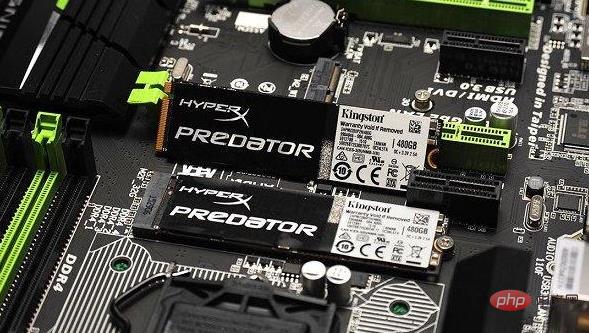
The m.2 interface is used to install solid-state drives; the m.2 interface is a solid-state drive interface. It is a new host interface solution that can be compatible with multiple communication protocols, such as SATA, PCIe, and USB. , HSIC, UART, SMBus, etc.

The operating environment of this tutorial: Windows 10 system, Dell G3 computer.
What is the use of the m.2 interface?
The two M.2 on the motherboard are solid-state drive interfaces, which are used to install solid-state drives. The SSD solid-state drive with the SATA interface is faster and takes up less space. M .2 interface can be converted to PCIE or SATA interface.
The M2 interface has a larger transmission capacity than SATA3:
SATA3 is 6Gb/s, which is equivalent to a transmission speed of 750MB/s.
M2 is 10Gb/s, which is equivalent to a transmission speed of 1.25GB/s.
High-specification enterprise-level solid-state drives have a faster M2 interface, while ordinary household solid-state drives are faster with SATA3.0 due to their low material quality.

Extended information:
The M.2 interface is a new host interface solution that is compatible with multiple communication protocols, such as sata, PCIe, USB , HSIC, UART, SMBus, etc.
The M.2 interface is a new generation interface standard tailored for Ultrabooks to replace the original mSATA interface. Whether it is smaller size or higher transmission performance, M.2 is far better than mSATA.
M.2 interface is a new interface specification introduced by Intel to replace MSATA. In fact, for desktop users, the SATA interface is enough to meet the needs of most users. However, considering the storage needs of Ultrabook users, Intel has eagerly launched this new interface standard. Therefore, we have seen this new M.2 interface on the new 9 series motherboards released by ASUS, Gigabyte, MSI, etc., and it is now popular.
Compared with MSATA, M.2 mainly has two advantages. The first is the advantage of speed. There are two types of M.2 interfaces: Socket 2 (B key——ngff) and Socket 3 (M key——nvme). Socket2 supports SATA and PCI-E X2 interfaces, and if the PCI-E ×2 interface standard is used , the maximum reading speed can reach 700MB/s, and the writing speed can also reach 550MB/s. Socket 3 among them can support PCI-E ×4 interface, with a theoretical bandwidth of up to 4GB/s.
The second one is the size advantage. Although the size of MSATA solid-state drives is small enough, compared with solid-state drives with M.2 interface, MSATA still has no advantage at all. Like mSATA, M.2 standard SSD can be arranged with single-sided NAND flash memory particles or double-sided arrangement. The total thickness of single-sided arrangement is only 2.75mm, while the thickness of double-sided arrangement is only 3.85mm. The size disadvantage of mSATA is much more obvious. The size of 51mm×30mm makes mSATA not have an advantage in area, and the single-sided layout thickness of 4.85mm is too thick compared with M.2. Plus, M.2 offers higher storage capacity even at the same size.
For more related knowledge, please visit the FAQ column!
The above is the detailed content of What is the use of m.2 interface?. For more information, please follow other related articles on the PHP Chinese website!